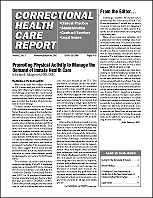The Use and Abuse of Restraints in Corrections
Author: David L. Thomas.
Source: Volume 08, Number 05, July/August 2007 , pp.65-68(4)

< previous article |next article > |return to table of contents
Abstract:
Restraint is a necessary part of both adult and juvenile corrections. Correctional officers and correctional healthcare personnel frequently are responsible for individuals with poor impulse control, a lack of contact with reality, explosive personalities, and/or manipulative sociopathies. Restraint is often necessary to protect these individuals from themselves as well as the harm they may cause others. Restraint may be physical, mechanical, or pharmacologic. Each method has its own inherent risks and benefits.Restraint is a necessary part of both adult and juvenile corrections. Correctional officers and correctional healthcare personnel frequently are responsible for individuals with poor impulse control, a lack of contact with reality, explosive personalities, and/or manipulative sociopathies. Restraint is often necessary to protect these individuals from themselves as well as the harm they may cause others. Restraint may be physical, mechanical, or pharmacologic. Each method has its own inherent risks and benefits.Keywords: civil, criminal liability, Time Limited, monitoring of patients, Death, Short-Term, Long-term Dangers, Mechanical Restraints
Affiliations:
1: Division of Correctional Medicine.